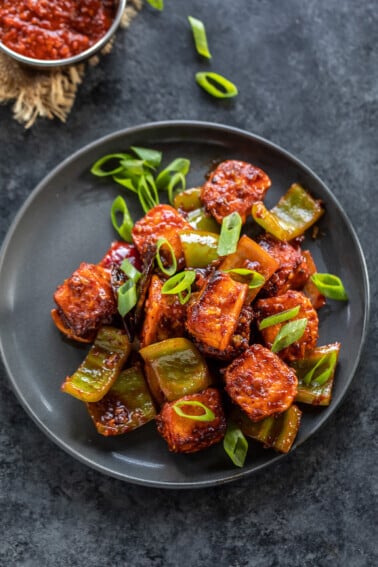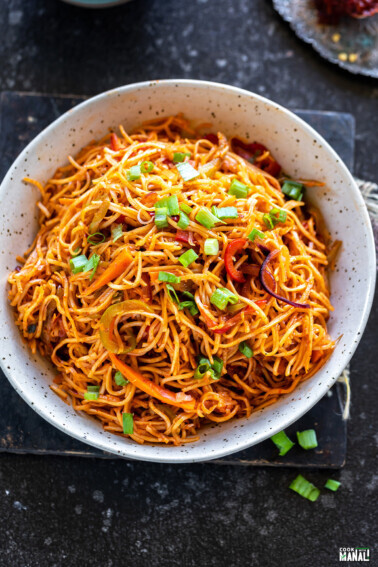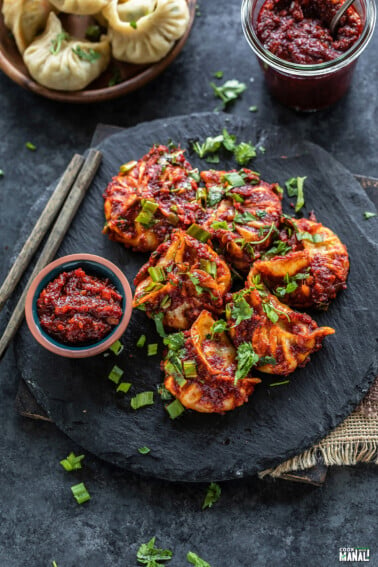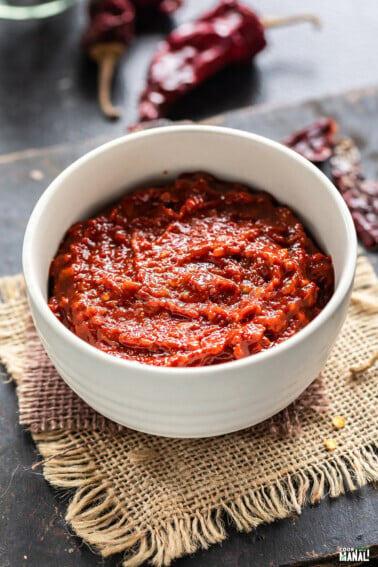Veg Chowmein (Street Style Chow Mein Recipe)
This Veg Chowmein Recipe makes street style chowmein which is loaded with vegetables and packed with flavor. It is also vegan!
This post may contain affiliate links. Please read our disclosure policy.
Chowmein is a popular Asian dish where stir fried noodles are tossed with lots of vegetables and sauces. This recipe is of the Indian street style veg chowmein noodles which is an integral part of the Indo Chinese cuisine. This recipe is packed with flavor, veggies and is also very easy to make. It is also vegan and can be easily made gluten free.
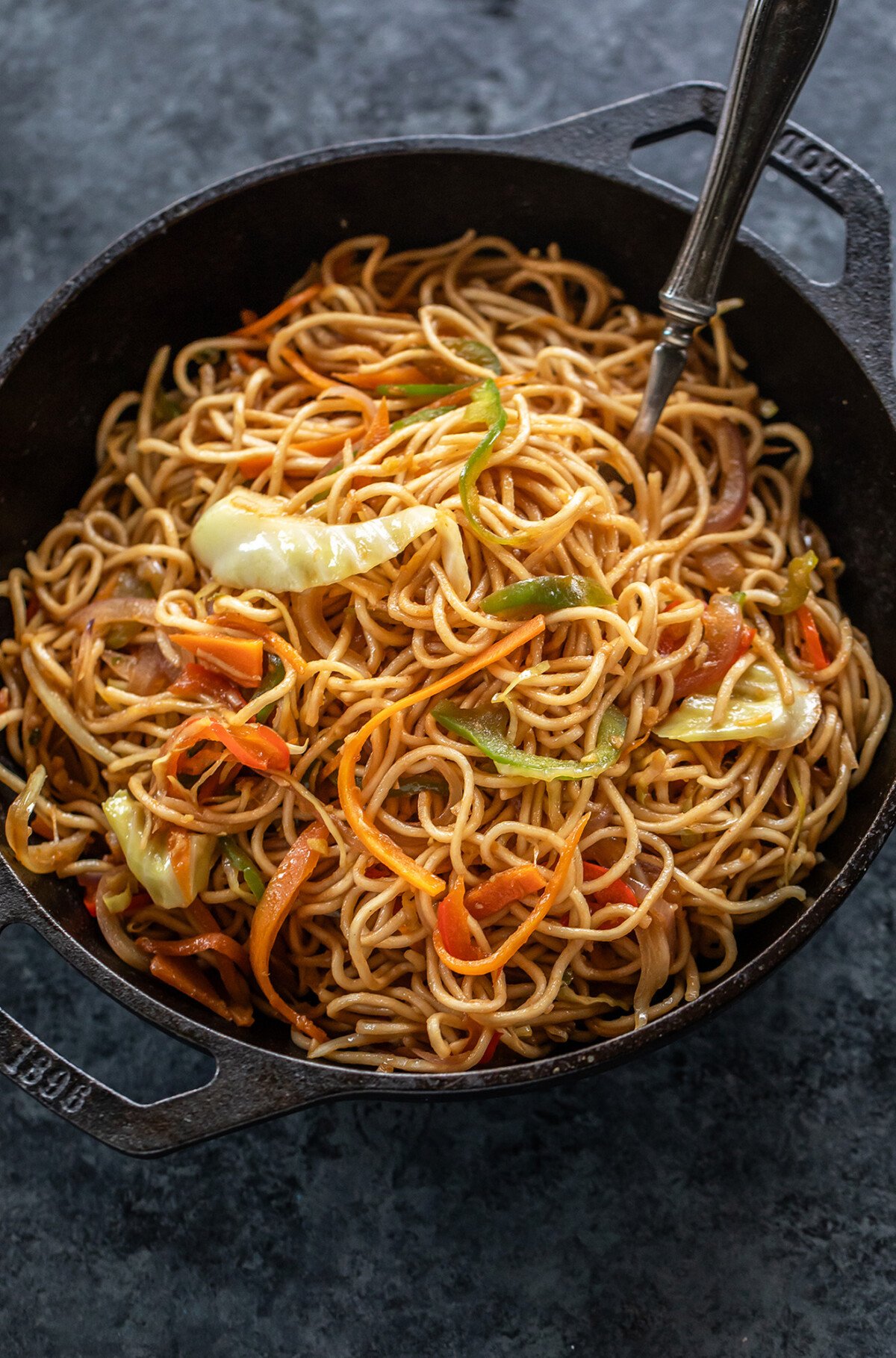
I am sure a lot of kids who grew up in India in the 90s would relate to the statement I am about to make. Every birthday party we went to as kids, we usually had a piece of cake along with a bowl of veg chowmein and samosa. Sometimes there was also a vegetable puff. That was a set standard menu and I am sure so many of you can relate to it. Of course birthday parties in India have now changed and how! Those were simpler days. 🙂
Veg chow mien became popular in India even before Indo Chinese as a cuisine became popular. It was the pioneer dish, the rest like gobi manchurian, chilli paneer came much later. I still remember how much I loved the chowmein sold at my school cafeteria. It was rupees 8 or 10 and it was my favorite treat when I had the money to splurge at the school canteen!
Making chow mein noodles at home is easier than you think. The only time consuming part of this recipe is chopping all the vegetables thinly. And if you have a mandoline slicer, then this process takes hardly 5 minutes! If you love making any kind of noodles with veggies, then I suggest you invest in a good mandoline slicer, it makes it so easy!
Table of Contents
What Vegetables are Used in Chow Mein
In the traditional Chinese version, vegetables like bok choy, bamboo shoot, and bean sprouts are used. However we are talking about the Indian street style chow mein here, and in that version we usually have onions, cabbage, carrots, and bell peppers. Spring onions are also often added. We also add lots of ginger, garlic and green chilies.
The vegetables need to be thinly sliced for chow mein and ideally they should of the same thickness. I don’t know about you, but I certainly don’t have the skills to chop them all to the same thickness and that too quickly. And that’s why I love my mandoline slicer (I love the one from OXO). I just set the thickness to 1/8th or a little less than 1/8th sometimes and slice. I am done slicing all the vegetables in 5 to 10 minutes, believe it or not!
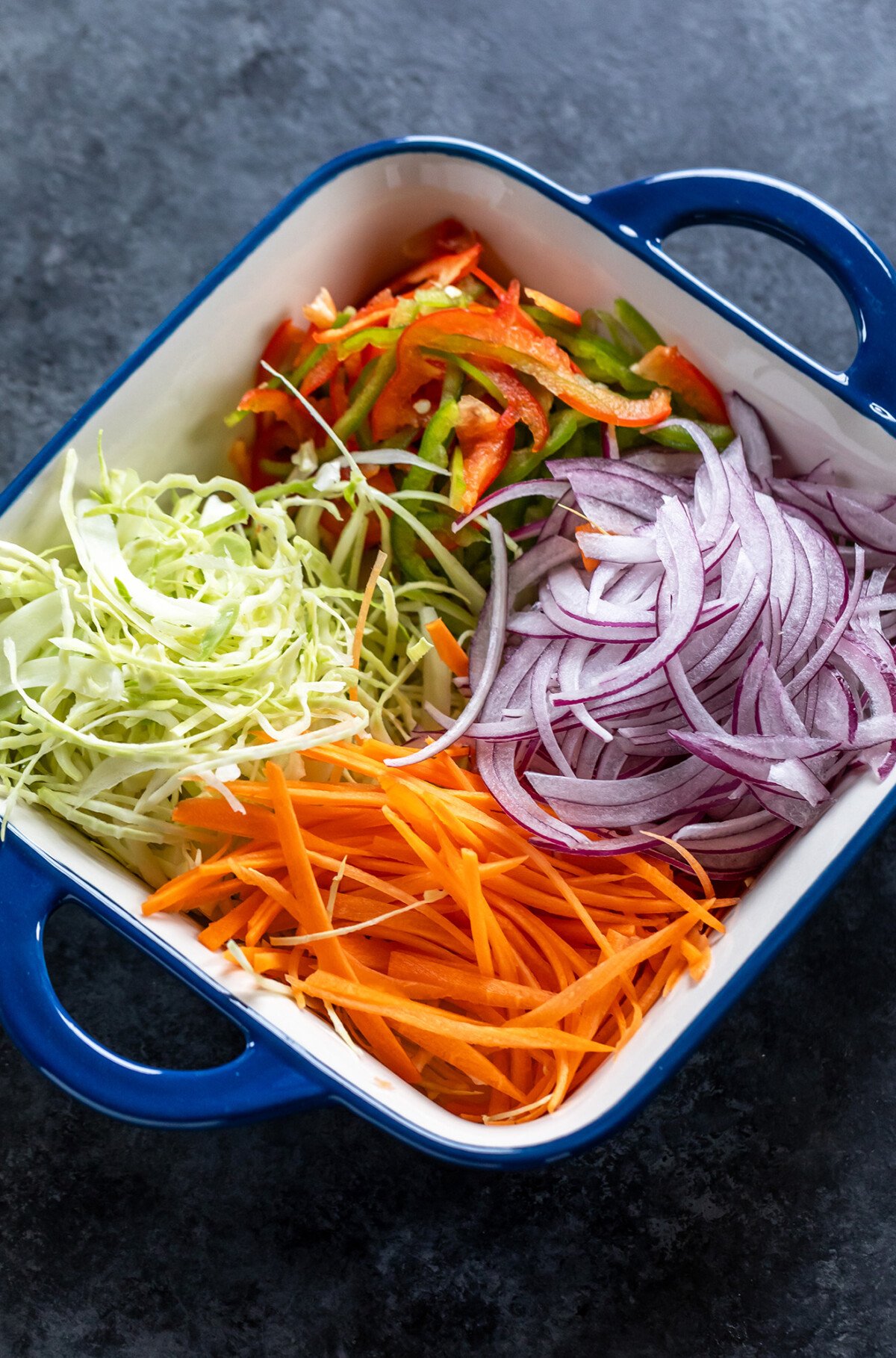
How to Cook Noodles Perfectly
There are two things when it comes to noodles in chow mein. First, you have to use the right kind of noodles. And two you have to cook them perfectly making sure they don’t clump or stick together after boiling.
I use Chings’s hakka noodles for this recipe and I think they work great. You can find regular noodles as well as whole wheat noodles at Indian grocery stores. Boil the noodles according to the instructions on the package. Here are few things to keep in mind:
- Don’t over cook the noodles. They should have a nice bite to them aka they should be al dente. So carefully monitor the cooking time.
- Once boiled, use a strainer to drain the water and then run the noodles under running cold water to stop the cooking process.
- And finally (and very important), toss the noodles with 1/2 to 1 tablespoon of oil and mix to coat the noodles with oil. This will prevent sticking of the noodles so that once you add them to the vegetables, they remain non-sticky and separate.
Ingredients
- Noodles: As mentioned above, I have used Ching’s brand hakka noodles. If you have a personal favorite brand, you can use that.
- Vegetables: I have used green cabbage, onions, red and green bell peppers, spring onion and carrots. You can also use mushrooms if you like mushrooms.
- Sauces: For this veg chow mein recipe, we use various sauces like soy sauce, vinegar, red chili sauce. You can use any brands for these sauces. I usually have an assortment of sauces from Asian and Indian grocery stores.
- Ginger-Garlic: I like using tons of ginger and garlic for this recipe. Use a food processor to chop them fine and fast.
How To Make Veg Chowmein – Step by Step
Before you start, have your veggies ready to go. I use a mandoline slicer to slice the veggies and then use a hand held chopper to finely chop my ginger, garlic and chilies.
- Bring a pot of water to boil. Once it comes to a complete oil, add 300 grams of noodles to the pot. Following the cooking time and instructions on the package of the noodles that you are using. I used Ching’s hakka noodles and followed the timings mentioned on the packet.
- Once the noodles are boiled, drain them using a strainer. Then place them under cold running water to stop the cooking process. Toss the noodles with 1/2 to 1 tablespoon of oil. This helps in preventing the noodles from sticking. Set this aside.
- Now, take a wok and add 1 & 1/2 tablespoon of oil to it and heat it on medium high heat. Once the oil is hot, add 1 & 1/2 tablespoon of finely chopped ginger, 4 to 5 finely chopped garlic cloves and 2 finely chopped green chilies. Stir constantly and sauté for around 1 minute, make sure the ginger and garlic do not burn.
- Then add 1 medium red onion (thinly sliced) to the wok and cook for 1 minute on high heat.
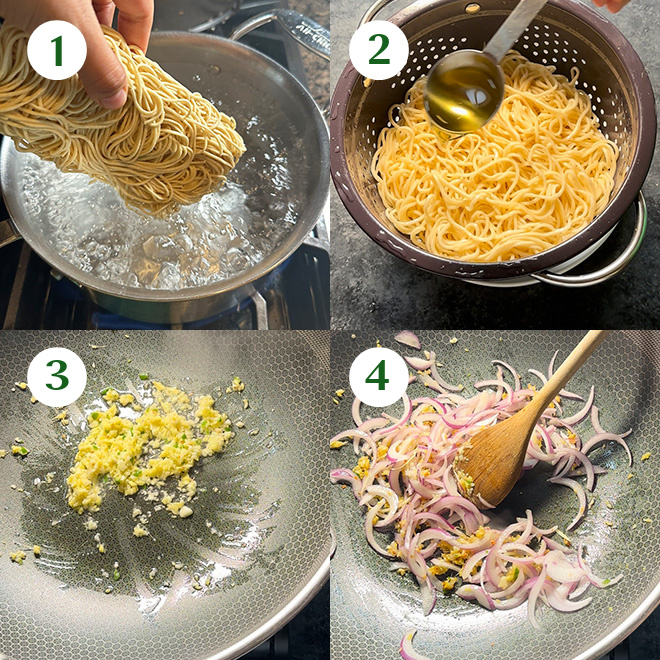
- Then add all the thinly sliced vegetables – 1 large carrot, 1 medium green pepper, 1 medium red pepper and 1 & 1/2 cups thinly sliced green cabbage.
- Cook these vegetables for around 2 minutes, they need to remain crunchy so do not overcook them.
- Add the boiled noodles into the wok and then add all the sauces: 2 & 1/2 tablespoons soy sauce (I used a combination of regular and dark soy sauce), 1 tablespoon white vinegar, 1 tablespoon tomato ketchup, 1 teaspoon red chili sauce (or any hot sauce), and 1 teaspoon green chili sauce. Also, add 1 teaspoon sugar, 1/4 teaspoon white pepper powder, black pepper and salt to taste (1/2 to 3/4 teaspoon).
- Now, stir using a pair of tongs until the noodles are well coated with the sauce. This takes around 2 minutes, and you can lower the heat during this time if you want. Garnish with spring onions if you like and your veg chowmein is ready.
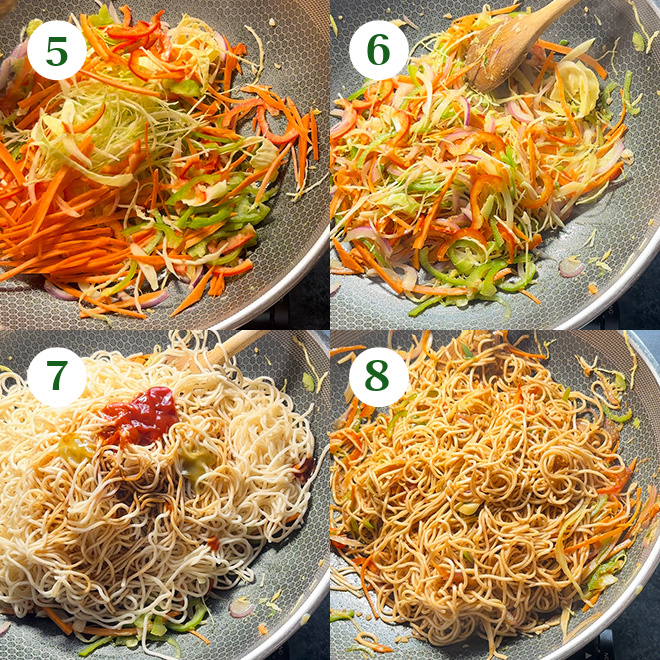
Tips For Success
- Chop the vegetables to same thickness, this gives the best texture when you are eating the chowmein. The vegetables need to be thinly sliced and I really trust my mandoline slicer for this. It slices them all to the same thickness and also does the job so quickly!
- Use a wok to make the chowmein. Using an iron or carbon steel wok definitely makes a difference to the final taste of the dish.
- Toss the noodles with a little oil once they are boiled. This ensures that they don’t clump up together. This way they are non sticking together when you add them to the wok along with the veggies and sauces.
- Don’t overcook the vegetables. This is crucial for that crunchy texture of the vegetables that we all love in a chowmein. Cook on high heat so that the veggies remain crunchy.
- I have not added MSG aka ajinomoto here but if you want you can add some for more of that authentic flavor and taste.
Veg Chowmein Recipe
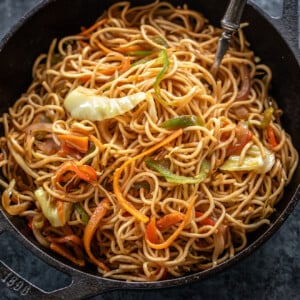
Ingredients
- 300 grams noodles I used chings brand hakka noodles
- 2 & ½ tablespoons oil divided, I used avocado oil
- 1 & ½ tablespoon ginger finely chopped
- 4-5 large garlic cloves finely chopped
- 2 green chilies finely chopped
- 1 medium red onion thinly sliced using a mandoline slicer
- 1 large carrot or 2 medium, thinly sliced using a mandoline slicer
- 1 medium green pepper thinly sliced using a mandoline slicer
- 1 medium red pepper thinly sliced using a mandoline slicer
- 1 & ½ cups green cabbage thinly sliced using a mandoline slicer
- 2 & ½ tablespoons soy sauce I used a combination of regular and dark soy sauce, you can use just regular one
- 1 tablespoon white vinegar
- 1 tablespoon tomato ketchup
- 1 teaspoon red chili sauce or any hot sauce, add more if you prefer spicy
- 1 teaspoon green chili sauce I used Chings brand
- 1 teaspoon sugar
- 1/4 teaspoon white pepper powder
- black pepper to taste
- salt to taste, around 1/2 to 3/4 teaspoon
- green onion chopped, to garnish
Instructions
- Before you start, prep everything. Slice the vegetables using a mandoline slicer. Finely chop your ginger, garlic and green chilies using a food processor. We want everything nicely chopped for this recipe. It will make a difference to the final taste of the dish.
- To cook the noodles, bring a pot of water to boil. Once the water starts boiling, add the noodles and cook according to the instructions on the package. Once noodles are cooked, drain the water and rinse the noodles under running water to stop the cooking process. Then toss them in 1/2 to 1 tablespoon of oil so that they do not stick. Set aside.
- Heat a work on medium-high heat. Add the remaining 1 & 1/2 tablespoon oil to the wok. Once the oil is hot, add the chopped ginger, garlic and chilies. Sauté for 1 minute making sure you don't burn the ginger garlic. Then add the sliced onions and cook for 1 minute. The heat should remain high medium.
- Now, add the remaining veggies- carrot, green pepper, red pepper and cabbage. Cook the vegetables for 2 minutes on high heat. They should remain crunchy.
- Then add the boiled noodles to the wok along with all the sauces- soy sauce, white vinegar, tomato ketchup, red chili sauce, and green chili sauce. Also add sugar, white pepper powder, black pepper and salt to taste.
- Now, stir using a pair of tongs until the noodles are well coated with the sauce. This takes around 2 minutes, and you can lower the heat during this time. Garnish with spring onions if you like and your veg chow mein is ready.
Notes
- You can make this recipe gluten free by using your favorite gluten free noodles. Also make sure to use gluten free soy sauce in that case.
- If you wish to add protein to your chowmein, you can try adding fried paneer or tofu to it. Traditionally though, these are never added to the recipe.
- Don’t overcook the noodles, they should have a firm bite to them. Do not overcook the vegetables either, they need to be crunchy.
Nutrition
Nutrition information is automatically calculated, so should only be used as an approximation.

